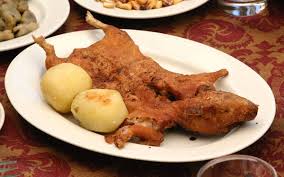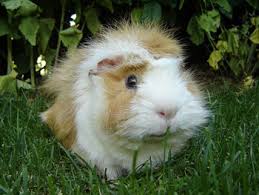Now first let’s do the legal stuff, California’s anti-pet-eating law has a broad reach that may cover eating guinea pigs. The California law protects “any animal traditionally or commonly kept as a pet or companion,” rather than just Fido and Fluffy. The statute is somewhat untested, though, so no one really knows which animals are included. I don’t know about other states, so I suggest you check in your area before you get in trouble.
Now I know that you have all seen the guinea pigs that our kids have kept for pets. But I will bet that most of you don’t know that is some parts of the world they are regularly eaten and are considered delicious.
Now some are starting to show up in South American restaurants in various parts of the US. The demand is created by immigrants from Ecuador, Peru and Colombia, where they are part of the regular menu.
The advantages of raising guinea pigs for food include. Guinea pigs don’t require much space. They can be kept in backyards, or in your home. They’re docile and easy to raise, They breed quickly and can be fed anything you would give a rabbit. A guinea pig farm consisting of two males and twenty females can sustain itself and feed a family of six. Friends of mine who spend part of every year in Peru say that is it common to see guinea pigs being raised and sold in the markets. They are called cuy in South America.
They are served in several different ways. You can make them stuffed and roasted, quartered and covered with a hot spicy sauce, or flattened whole and fried.
Here is a Peruvian recipe for fried guinea pig.
- 1 guinea pig, de-haired, gutted, and cleaned
- 1/2 c. flour
- 1/4 – 1/2 t. ground cumin
- salt and black pepper to taste
- 1/2 c. oil

Dry the skin of the guinea pig and rub in the cumin, salt, and pepper. Coat the carcass with the flour and place it on its back in the preheated oil, turning it to cook both sides. Alternately, the guinea pig can be cut and fried in quarters.
Serve with boiled potato, and a salad of cut tomatoes and slivered onions bathed in lime juice and a bit of salt.
If you decide to raise guinea pigs, you will find that there are several different varieties, some of which will weigh up to 7 pounds each. They are high in protein and low in cholesterol. They can be raised in a basement or garage and are not noisy so that you can keep them hidden and preserve your operational secrecy. Just be sure not to let your kids start naming them or you will have problems when it is time to eat them.
Howard


Young groundhog or woodchuck can be prepared the same way. My Dad told me that during the Depression they were an important food source and actively hunted in the spring before they grew large enough to damage vegetable gardens and food crops. A common Southern recipe is in a pot roast cooked with cabbage, potatoes, carrots and onions, flavored with Tabasco sauce and a bottle of Coca Cola. If you don’t have Coke the traditional Tex-Mex, Cajun or Peruvian seasonings will be absolutely splendid!
Way back in WWII we had meat rationing and I had 6 younger siblings. I was 9 – 12 during that time and my job was to raise and butcher rabbits for the dinner table. It was an easy job that didn’t take much time. We ate lots rabbit meat!!! And, their droppings worked fine in the veggie garden that my mother had in the backyard near the rabbit hutches.
BUT – for me there is now a problem with raising rabbits. That is – one rabbit provides way too much meat for just one person to eat at a meal. Guinea pigs could solve that problem.
Thanks for the tip. I think I’ll try it.
Hangtown Frank
Thanks for the article, I’d never heard of this before. Can you tell me, what is the benefit of raising Guinea Pigs over rabbits? I would think that rabbits will breed faster, their fur can be harvested and utilized without question, and they’d surely be more acceptable as a food source to Americans who are unfamiliar with Guinea Pigs on the dinner table.
Ken McClelland
The Pandemic Preparedness Guide
Guinea pigs can be raised indoors, and won’t attract the attention from your neighbors
For me, another benefit of guinea pigs over rabbits is allergies. I am so allergic to rabbits I can’t be with in five feet of them, outdoors! But I can vacuum and clean a room with two guinea pigs with no trouble at all.
Teresa
I’m looking forward to trying cuy (guinea pig) this Spring when my wife and I visit Macchu Picchu in Peru. I recently tried fried rat while on a Mekong River cruise in Vietnam. There is less meat on a rat, but I think that raising them for food, as they do in Southeast Asia, would make for a viable food source as well. In Vietnam they are raised for food and it is illegal to catch and sell street rats. While it sounds revolting to most people, including my fellow cruise passengers, they don’t taste bad at all.
I’ve eaten a lot of strange things in my life — dog meat, sea slugs, grasshopperss, crickets — never eaten guinea pig, though.
Advantages over rabits is they dont/cant escape a simple wooden box….where i saw them in Equador there were no predators and the box didnt even have a top. Feed was cut grass. I think they grow /breed fast.
People describe everything as tasting like chicken, but cuy tastes like duck. Its ok, a bit greasy, like dark poultry meat. Good tuesday nite fare.
Oh my god I cant believe someone in the USA would do this! I have 3 guinea pigs and it makes me throw up just thinking of this!
I’m wondering about the fat ratio for a cuy? In an ‘extreme’ situation, of the critical three required macro nutrients (carbohydrates, proteins and fats), carbs will be the easiest (root crops, fruit, etc), protein from animals, but the fat might be the problem. In the case of small animals (not counting pigs :), rabbits have no fat, ducks have a lot… how do guinea pigs stack up in providing this nutrient? Thanks!
They have a decrnt amount of “tallow” for their size, which is the fat next to the kidneys. If you eat them with the skin, which is usually done, they have a goid amount of fat. If you skin them, its quite a bit lower.
Would it help if they were made into nuggets and came with BBQ sauce?